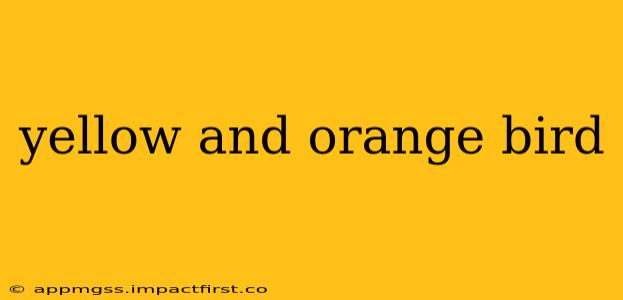The vibrant hues of yellow and orange make for some of the most striking birds in the world. From the bright flashes of a flitting sunbird to the bold plumage of a larger species like an oriole, these colors often signal a bird's breeding status or serve as camouflage within its specific habitat. Identifying these birds requires a keen eye and attention to detail, looking beyond just the dominant colors. This guide will help you differentiate between some of the common yellow and orange birds found around the world, addressing some frequently asked questions along the way.
What are some common yellow and orange birds?
This is a broad question, as the answer depends greatly on your geographic location. However, some commonly seen species with prominent yellow and orange coloration include:
- Orioles: Known for their vibrant orange and black plumage, orioles are found across the globe, with variations in specific coloration. Baltimore Orioles in North America, for example, are a striking combination of black and orange, while other species might incorporate more yellow.
- Sunbirds: These nectar-feeding birds, primarily found in Africa and Asia, exhibit a dazzling array of colors, often with brilliant yellow and orange accents. Many sunbird species are small and agile, making identification challenging.
- Tanagers: A large family of birds found in the Americas, many tanagers boast bright yellow and orange plumage, often with contrasting colors like red or black. Scarlet Tanagers, for instance, are famous for their stunning blend of scarlet and yellow.
- American Goldfinches: These small, cheerful birds are easily identified by their bright yellow bodies, particularly during breeding season. Their coloring can vary slightly throughout the year.
- Yellow-rumped Warblers (Butter Butts): These warblers are known for their distinctive yellow rump patches, visible during flight. They are common winter visitors to many areas.
What bird is yellow and orange and small?
Several small birds display yellow and orange coloration. To narrow down the possibilities, consider these factors:
- Location: Where did you see the bird? This is crucial, as different regions have different bird species.
- Habitat: Was the bird in a forest, a field, a backyard? Different habitats attract different birds.
- Behavior: What was the bird doing? Was it foraging on the ground, flitting among flowers, or perching in a tree? This can offer significant clues.
- Specific shades of yellow and orange: Were the colors bright and intense, or more muted and pastel? Were there any other colors present, such as black, red, or green?
Consider using a bird identification app or guide specific to your region to help narrow down the possibilities based on these observations.
What bird has a yellow belly and orange chest?
This description doesn't pinpoint a single species, but it narrows down the possibilities. Again, knowing your location and habitat is crucial. Some birds that might fit this description (depending on the exact shade of yellow and orange and other markings) include certain species of warblers, tanagers, and smaller flycatchers. Using a detailed bird identification guide or app, and paying close attention to other physical characteristics, is essential for proper identification.
Is there a bird that is all yellow and orange?
While many birds exhibit both yellow and orange, it’s rare to find a species that’s entirely composed of these two colors. Most birds with these colors will have other features—such as black, brown, or green—on their wings, tail, or head. The combination and pattern of these colors is key to identification.
How can I identify a yellow and orange bird?
Bird identification requires a combination of skills and tools. Here's a systematic approach:
- Note the location: Knowing where you observed the bird will drastically reduce the possibilities.
- Observe its size and shape: Is it small, medium, or large? What's the shape of its beak and tail?
- Examine the plumage: Pay close attention to the specific shades of yellow and orange, and any other colors present. Note the patterns and markings.
- Watch its behavior: What was it doing? How did it move?
- Consult a field guide or bird identification app: Use resources specific to your region. Many apps allow you to input descriptions and characteristics for accurate identification.
- Take a photo (if possible): A photo will allow for more detailed examination later.
By employing careful observation and utilizing the appropriate resources, you'll greatly improve your chances of successfully identifying any yellow and orange bird you encounter. Remember, patience and attention to detail are key to successful bird watching!
